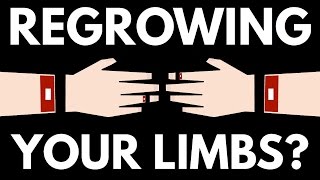(单词翻译:单击)
Hey there! Welcome to Life Noggin.
大家好!欢迎来到脑洞大开的生命奇想。
Have you ever wondered if it was possible for humans to regrow body parts? Why is it that when a person loses an arm, only the wound is healed rather than the body regrowing their lost limb?
你是否曾想过人类有没有有可能再生身体部位?为什么人失去手臂时,只有伤口愈合,身体却没有重新长出失去的肢体?
In the spirit of Dr. Connors, let's find out. I just hope we don't all turn into Spider-Man villains. So humans can't regrow their own limbs, correct? Well, that might not be entirely true.
本着康纳斯博士的科学精神,我们来看看。我只是希望我们不要变成蜘蛛侠里的坏蛋。所以人类不能再生自己的肢体,对吧?这可能不是完全正确的。 As an embryo, long before your birth, you may have had the ability to replace your developing limbs.
As an embryo, long before your birth, you may have had the ability to replace your developing limbs.
早在你出生之前,还是胚胎的时候,你就可以更换自己尚在发育中的肢体。
Through scientific surgery, researchers have shown that at the embryonic stage of development, frogs can regenerate their developing limbs. This has even been shown in mice, which like humans, are mammals.
通过科学手术,研究人员发现,在胚胎发育阶段,青蛙可以再生四肢。这一点甚至在老鼠身上也有体现,它们像人类一样,也是哺乳动物。
It is yet to be proven the same with human embryos, but with this evidence, the theory is that vertebrate embryos, including humans, can regenerate their limbs if they are damaged or amputated.
同样的情况能否发生在人类胚胎身上,还有待证明,但有了这一证据,该理论认为,包括人类在内的脊椎动物胚胎,如果被损坏或被截肢,可以再生肢体。
However, other than a few special and small cases like the regeneration of fingertips, humans don't really have this ability after birth. But do any other animals?
然而,除了一些特殊的小案例,如指尖的再生,人类在出生后并没有具备这种能力。但是其他动物呢?
Well it just so happens that salamanders have this super awesome superpower! They are the only vertebrate that can regrow their limbs and many other body parts throughout their lifetime.
好吧,蝾螈目动物有这个超棒的超能力!它们是唯一能再生四肢和其他身体部位的脊椎动物。
In fact the axolotl, a Mexican salamander, can regenerate almost anything: from their eyes, to their spinal cord, to even parts of their brain. These adorable little guys are amazing! I want 20 of them.
事实上,墨西哥蝾螈,几乎可以再生任何部位:从眼睛,到脊髓,甚至是大脑的一部分。这些可爱的小家伙真了不起!我要20个。
So how do salamanders do it? Well, when a human losses a limb, their cells close the wound and a blood clot forms. This leads to a scab over the wound and an eventual scar in the place of where the limb was.
那么蝾螈目动物是怎么做到的呢?当一个人失去了肢体,他们的细胞就会闭合伤口,形成血块。这导致伤口结痂,最终在失去肢体的地方形成疤痕。
But for a salamander, scar tissue never forms; a striking difference between their regeneration and human wound healing. A salamander's wound closes more rapidly and cells rush to the amputation site.
但蝾螈的伤疤组织永远不会形成;这是他们的再生功能和人类伤口愈合之间的显著差异。蝾螈的伤口愈合得更快,细胞会冲向失去肢体的位置。
These cells revert back to a less specialized state and begin creating the blastema, which is the bud of a new limb. As the blastema grows, it begins to form the outline of the new limb and the foot.
这些细胞恢复到一个不那么特殊的状态,开始产生胚基,这是新肢体的芽。随着胚基的生长,它开始形成新的肢体和脚的轮廓。
The cells begin creating new tissue by proliferating and differentiating into things like muscle and bone. The new leg lengthens, filling out the missing segments between the amputation site and the toes.
细胞开始增殖和分化成肌肉和骨骼之类的东西,以产生新的组织。断肢部位新生的腿长长,最终长出脚趾。
The whole process usually lasts around two months, and then the salamander has a fully regenerated limb. It's perfect for a cute little high five! Go science! But in humans, the blastema never grows.
整个过程通常持续两个月左右,然后蝾螈会有一个完全再生的肢体。正好可以击个可爱的小掌了。去吧科学!但人体永远不会长出胚基。
Some scientists think that's because humans don't have all the genes necessary to facilitate such a level of regeneration.
一些科学家认为这是因为人类没有这种水平的再生需要的所有基因。
But others think that humans don't have this regenerative ability because it might make them more likely to develop cancers. But even if humans could regrow their limbs, there still might be an issue.
但也有人认为人类没有这种再生能力,是因为这可能会使他们更容易患上癌症。但是,即使人类可以再生他们的四肢,仍然可能存在一个问题。
Let's take a look back at that adorable little axolotl with the findings of two recent studies.
让我们来回顾一下这个可爱的小蝾螈,最近关于它的两项研究结果。
The researchers found that, like biological wrecking balls, certain jumping genes need to be shackled in the axolotl's cells or they might disrupt their process of regeneration.
研究人员发现,像生物破坏球一样,某些跳跃基因需要在蝾螈细胞中被束缚,否则它们可能会破坏再生过程。
They discovered that proteins found within the little water monsters allow them to prevent these jumping genes from causing havoc. So, regeneration is really complicated and maybe for right now, humans can't regrow their limbs.
他们发现,在这些小水怪体内发现的蛋白质可以防止这些跳跃基因造成破坏。所以,再生是非常复杂的,也许现在,人类还不能再生四肢。
But these studies at least give scientists hope that we could learn better methods for treating human conditions, like wound healing and regenerating simple tissues. Hey, even just becoming a little bit more like Wolverine would be awesome!
但这些研究至少给了科学家们希望,我们可以学习更好的治疗人类疾病的方法,比如伤口愈合和简单组织的再生。嘿,就算变得有点像金刚狼也很棒!
I'm Blocko, and I'm the best at science communication. And I have claws. Eat your heart out, Hugh Jackman! So what do you think? What limitations of humanity would you like science to be able to overcome?
我叫宝高,我是科学传播领域的佼佼者。我有爪子。颤抖吧,休·杰克曼!你有什么想法?你希望科学能够克服人类什么限制?
Let me know in the comment section below! Have you ever wondered why winter doesn't kill all the plants and fish? Check it here.
请在评论区告诉我!你有没有想过为什么冬天所有的植物和鱼都不会冻死?看这里。
Lucky for our aquatic friends, when the temperature outside falls below the freezing point of water, only the top layers of the lakes or rivers typically freeze.
我们的水生朋友们很幸运,当外面的温度降到冰点以下的时候,湖泊或河流中通常只有最上层会结冰。
As always, I'm Blocko. this has been Life Noggin. Don't forget to keep on thinking!
我是宝高,这里是脑洞大开的生命奇想。思考不要停!


